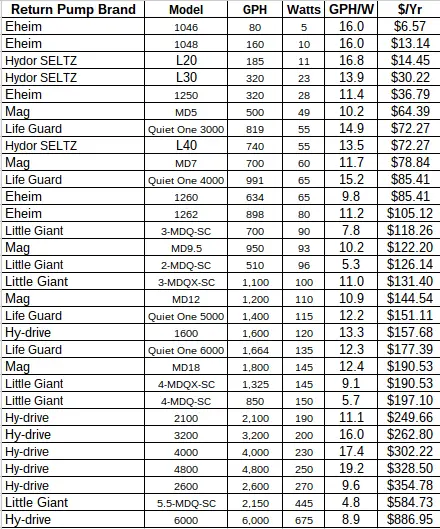Ever since I wrote the post last week about whether switching to reef LED lighting will save money, I have been almost obsessed with trying to understand how much electricity my saltwater aquariums are consuming. Next to the lights, the next most energy-intensive piece of equipment is the aquarium return pump–the electrical pump that returns water from the sump below my tank back into the aquarium.
But almost as important as understanding how much electricity my aquarium return pump is consuming is understanding how much electricity comparable pump models consume. So I did a quick comparison of 30 popular models of aquarium return pump and found that there is a really wide spectrum of efficiency across the popular pumps available as well as a wide range of operating costs (the cost to run the pump each and every year).
I was shocked when I found out that some aquarium return pump models can cost almost $900 a year to run! Are you kidding me?
Aquarium Return Pump Cost
Across the 5 brands and 30 models I compared—the median cost was $126.14. At the low end of the spectrum, the Eheim 1046 (affiliate link) model aquarium return pump uses an energy-sipping $6.57 of electricity over the course of an entire year,
while the energy-guzzling Hy-drive 6000 (affiliate link) chugs a whopping $886.95 each year. YIKES! Now in all fairness, those two pumps aren’t even in the same league. The Eheim aquarium return pump is only rated to move 80 gallons per hour, whereas the Hy-drive aquarium return pump moves 6,000 gallons per hour. But that kind of horsepower does come at a cost.
I based these calculations all on the assumption that the pumps run 24 hours a day, 365 days a year and that the electricity costs $0.15 per kilowatt hour. The table below lists all the calculations. The tables constructed below are based on the manufacturer’s information from Dr. Fosters and Marine Depot.

But energy consumption and cost are only one important consideration when evaluating a return pump. It seems reasonable to expect that a pump that generates a greater flow rate or pumps the water up to a greater height would consume more electricity. However, it seems fair to consider how much flow the return pumps generate per watt should be a reasonable proxy for the efficiency of the pumps.
Here is what I found out about pump efficiency:
The median pump on the list provides 11.7 Gallons Per Hour of flow per watt of energy consumption. The HY-Drive 4800 (affiliate link)
wins top efficiency scores pumping 19.2 Gallons per watt. Worst on the list is the Little Giant 5.5 MDQ-SC which gets only a meager 4.8 Gallons per watt. Ouch!
Note GPH per watt
Clearly, flow is important—very important for a reef tank. And to some extent, the turnover of the water volume in the tank is going to relate to filtration efficiency—but these big pumps may be able to push a lot of water uphill, so-to-speak, but they sure do burn some electricity.
I encourage you not to judge an aquarium return pump strictly by the cost of electricity—you have to consider optimal turnover rate for your aquarium, ability to provide sufficient flow at the head pressure required, reliability and ease of maintenance, among other things—but I also think it’s helpful to know some of the numbers—and whether or not one model pump is going to cost you significantly more than the others to run each and every year.
If you are wondering what return pumps I use, I run Mag Drive Pump Model MD 7 (affiliate link)
for my main saltwater tank (the display aquarium in my den)
I am pleased to see that for the output they provide, they appear to be appropriately efficient. As far as ease of use and low maintenance, they are great aquarium return pumps that have served me well.
Written by Albert B. Ulrich III.
The pictures and some links on this page contain affiliate links. If you click on those links and purchase anything as a result of that visit, a small amount of money will be contributed to help fund this website at no additional cost to you. I just wanted to disclose that relationship.


Leave a Reply